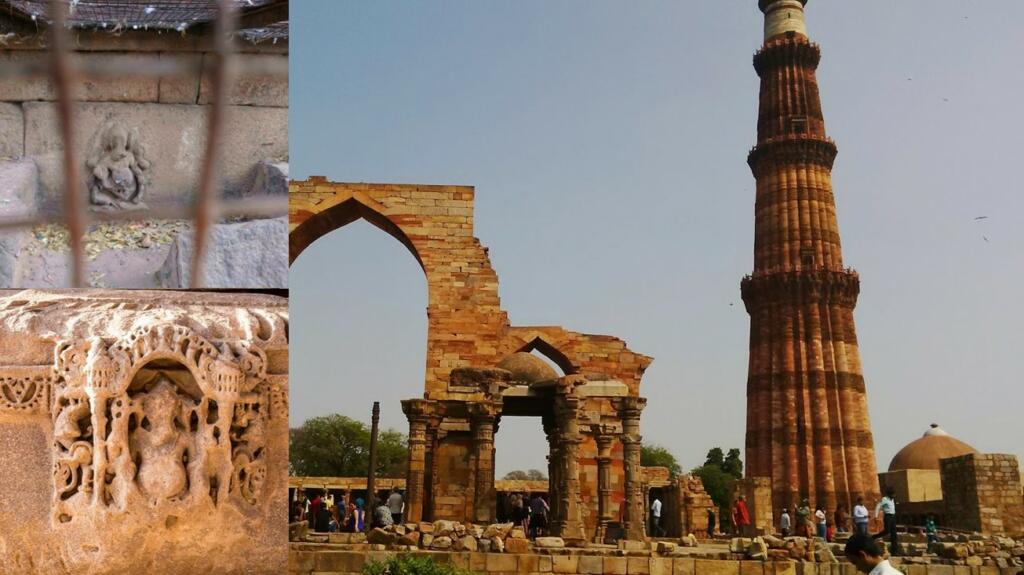Dhruv Stambh is in news again, not because of Hindus’ claim of worship, but rather because of an attempt to sabotage the history of Hindu civilization. The intellectuals refer to Dhruv Stambh as ‘Qutub Minar’, and in an attempt to whitewash the history of Islamic invasions, National Monuments Authority (NMA) has decided to remove the Ganesh idols from the Qutub Minar complex to some other ‘respectable place’. Here arises a question. Why has NMA adopted the method of removal rather than preservation?
NMA asks ASI to remove Ganesha idols
According to a report published by The Indian Express, the National Monuments Authority (NMA) asked the Archaeological Survey of India(ASI) last month to retrieve the murtis of Bhagwan Ganesh from the Dhruv Stambh as Qutub Minar Complex.
According to the report, the move is being seen in the backdrop that the NMA chairman thinks that the placement of idols within the complex “is disrespectful” and it is necessary to move it to some other “respectable” place at the National Museum. It has been mentioned in the communication sent to ASI that, it should be placed in National Museum where there is provision for such antiques to be displayed.
NMA chief Tarun Vijay has cited that since the idols come at the feet of the mosque, hence the placement is disrespectful.
Read More: Delhi Court may revive the ancient Hindu legacy buried inside Qutub Complex
Ganesh idols at Qutub Minar complex
Tarun Vijay in his statement to The Indian Express said, “After Independence, we removed the statues of British kings and queens from India Gate, and changed the names of roads to erase marks of colonialism. Now we should work to reverse the cultural genocide that Hindus faced at the hands of Mughal rulers.”
Vijay further elaborated that those two idols called the ‘Ulta Ganesh’ and ‘Ganesh in cage’ are located in the Qutub Minar complex, made in the 12th century.
Tarun Vijay claimed that these idols were snatched from those of Jain Tirthankaras and Yamuna, Dashavatar, and Navagrahas, after demolishing 27 Jain and Hindu temples built by King Anangpal Tomar and commented on the positioning of the idols and emphasized how their positioning marked the contempt for India.
Read More: Not Mughals; Chalukyas, Pallavas and Rashtrakutas deserve more attention in our history books
The location of the two idols is remarkable, the ‘Ulta Ganesh’ idol is situated at the south-facing wall of the Quwwat Ul Islam mosque that translates to ‘Power of Islam’ whereas the second idol of Ganesh enclosed in an iron cage, is located the ground level of the same mosque.
Dear Tarun Vijay, Murtis need preservation, not removal
Many appreciated the efforts of the NMA chief and looked at it as an attempt to correct Hindu history. But NMA chief missed a simple point, one can erase the marks of targeted cultural genocide by restoring the ancient glory and not by removing the idols from their ancient locations and putting them in museums.
This point was raised correctly by one of the Twitter users named Radharamn Das, who wrote, “This attempt to remove the Ganesh Deities from Qutub complex is an attempt to hide the wrongs done by Islamic invaders. The Ganesh Deities should never be shifted away. Instead return the Qutub complex to Hindus & let worship restarts once again.”
This attempt to remove the Ganesh Deities from Qutub complex is an attempt to hide the wrongs done by Islamic invaders. The Ganesh Deities should never be shifted away.
Instead return the Qutub complex to Hindus & let worship restarts once again. @ASIGoI @MinOfCultureGoI pic.twitter.com/VqmtQkAUyH
— Radharamn Das राधारमण दास (@RadharamnDas) April 7, 2022
Another Twitter user Ratan Sharda wrote on the same line, “If Ganesh murtis are in pitiable state, they should be given a due respectful place in the same campus. Removing them will remove the big evidence of Islamist vandalism.”
If #Ganesh murtis are in pitiable state, they should be given a due respectful place in the same campus. Removing them will remove the big evidence of Islamist vandalism. #QUTUBMINAR https://t.co/s58cMFK2Nd
— Ratan Sharda 🇮🇳 रतन शारदा (@RatanSharda55) April 7, 2022
Qutub Minar or Dhruv Stambh
According to the history designed and taught by the Left intelligentsia, the Qutub Minar complex was first made by the slave dynasty ruler Qutb-ud-din Aibak and was added to by many subsequent rulers.
Read More: Qutub Complex: An ancient Hindu legacy lies buried inside it
But as per the historical sources, the Quwwat al-Islam mosque was built in 1192. And inscriptions record that 27 Jain and Hindu temples were torn down for its creation. Pillars from the destroyed temples were reused and the Hindu images were plastered over with geometric designs.
‘Qutub Minar’ means ‘victory pillar’, and the central Mosque inside Qutub Minar is known as ‘Quwwat Ul Islam’, which translates to ‘Power of Islam’, indicating the victory of Islam over Idol worshipping Hindus.
According to a petition filed in Delhi’s Saket court, in the complex, there are still hundreds of fragments of idols of deities present that represent the cultural imposition by Islamic rulers.
Qutub Minar is one of the many architectures that glorify and chants about the genocide of Hindu culture by the Islamic invaders and the time has come to restore the ancient Hindu legacy buried under the Qutub Minar complex. But all of this is not possible with decisions like the removal of idols.
